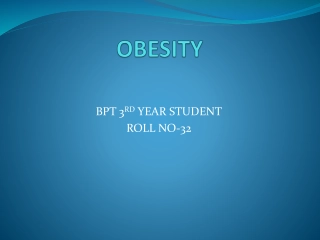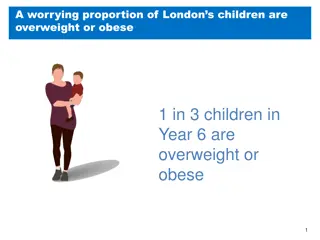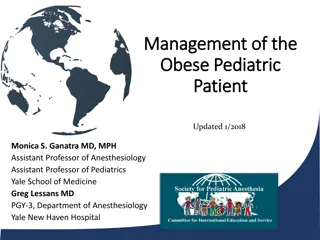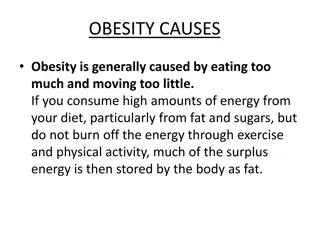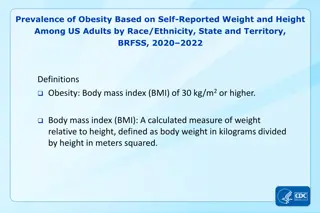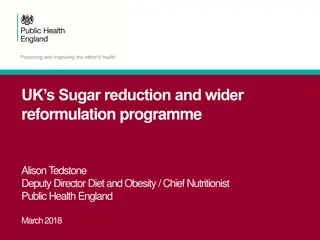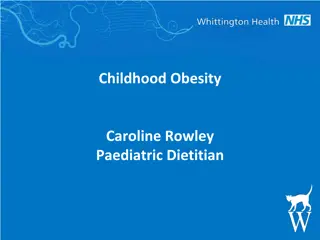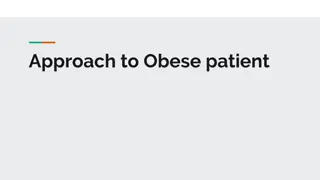Morbid Obesity
Morbid obesity, its definition, BMI, and the pathological consequences it has on health. Dr. Imran Abbas's medical unit at Sheikh Zayed Hospital in Rahim Yar Khan specializes in treating morbid obesity and related health conditions.
- Morbid obesity
- Dr. Imran Abbas
- Medical unit
- Sheikh Zayed Hospital
- Obesity definition
- BMI
- Pathological consequences
- Health conditions
Download Presentation

Please find below an Image/Link to download the presentation.
The content on the website is provided AS IS for your information and personal use only. It may not be sold, licensed, or shared on other websites without obtaining consent from the author. Download presentation by click this link. If you encounter any issues during the download, it is possible that the publisher has removed the file from their server.
E N D
Presentation Transcript
Morbid Obesity Dr Imran Abbas Medical Unit 2 Sheikh Zayed Hospital Rahim Yar Khan
What is Obesity For adults, WHO defines overweight and obesity as follows: Overweight is a BMI equal to or greater than 25 and Obesity is a BMI equal to or greater than 30.
What is BMI The body mass index (BMI) is a measure that uses your height and weight to work out if your weight is healthy. The BMI calculation divides an adult's weight in kilograms by their height in metres squared. For example, BMI= Weight(kg)/Height(m )
What is morbid obesity Class II obesity, formerly known as morbid obesity, is a complex chronic disease in which a person has a body mass index (BMI) of 40 or higher OR BMI of 35 or higher and is experiencing obesity-related health conditions.
Waist Circumference Excess abdominal fat, assessed by measurement of waist circumference or waist-to-hip ratio, is independently associated with a higher risk for diabetes mellitus and cardiovascular disease. Measurement of the waist circumference is a surrogate for visceral adipose tissue and should be performed in the horizontal plane above the iliac crest
Pathological Consequences Of Obesity Obesity has major adverse effects on health. Obesity is associated with an increase in mortality, with a 50 100% increased risk of death from all causes compared to normal-weight individuals, mostly due to cardiovascular causes. Mortality rates rise as obesity increases, particularly when obesity is associated with increased intra abdominal fat. Life expectancy of a moderately obese individual could be shortened by 2 5 years, and a 20- to 30-year-old male with a BMI >45 may lose 13 years of life. It is likely that the degree to which obesity affects particular organ systems is influenced by susceptibility genes that vary in the population.
Obesity Related Organ Tissue Review Cardiovaseular Hypertension Congestive heart failure Cor pulmonale Varicose veins Pulmonary embolism Coronary artery disease Endocrine Metabolic syndrome Type 2 diabetes Dyslipidemia Polycystic ovarian syndrome
Musculoskeletal Hyperuricemia and gout Immobility Osteoarthritis (knees and hips) Low back pain Carpal tunnel syndrome Psychological Depression low self-esteem Body image disturbance Social stigmatization
Integument Striae distensae Stasis pigmentation of legs Lymphedema Cellulitis Acanthosis nigricans Acrochordon (skin tags)
Repiratory Dyspnea Obstructive sleep apnea Hypoventilation syndrome OR Pickwickian syndrome Asthma Gastrointestinal Gastroesophageal Reflux disease Nonalcoholic fatty liver disease Cholelithiasis Hernias colon cancers
Genitourinary Urinary stress incontinence Obesity related glomerulopathy Hypogonadism (male) Breast and uterine cancer Pregnancy complications Neurological Stroke Idiopathic intracranial hypertension Meralgia paresthetica Dementia
TREATMENT Goals of Therapy; The decision of how aggressively to treat the patient and which modalities to use is determined by the patient s risk status, expectations, and available resources Setting an initial weight-loss goal of 8 10% over 6 months is a realistic target. Treatment strategies include 1. Lifestyle Management 2. Pharmacotherapy 3. Surgery
Lifestyle Management Diet Therapy: Guidelines from the American Heart Association/American College of Cardiology/The Obesity Society recommend initiating treatment with a calorie deficit of 500 750 kcal/d compared with the patient s habitual diet. Alternatively, a diet of 1200 1500 kcal/d for women and 1500 1800 kcal/d for men. For example choosing smaller portion sizes, eating more fruits and vegetables, consuming more whole-grain cereals, selecting leaner cuts of meat and skimmed dairy products, reducing consumption of fried foods and other foods with added fats and oils, and drinking water instead of sugar-sweetened beverages.
Physical Activity Therapy: The 2008 Physical Activity Guidelines for Americans recommend that adults should engage in 150 min of moderate-intensity or 75 min a week of vigorous-intensity aerobic physical activity per week, performed in episodes of at least 10 min and preferably spread throughout the week. A high level of physical activity (>300 min of moderate-intensity activity per week) is often needed to lose weight and sustain weight loss.
Behavioral Therapy: Cognitive behavioral therapy is used to help change and reinforce new dietary and physical activity behaviors. Strategies include self-monitoring techniques (e.g., journaling, weighing, and measuring food and activity); stress management; stimulus control (e.g., using smaller plates, not eating in front of the television or in the car); social support; problem solving; and cognitive restructuring to help patients develop more positive and realistic thoughts about themselves
PHARMACOTHERAPY Centrally acting anorexiant medications; By increasing satiety and decreasing hunger, these agents help patients reduce caloric intake without a sense of deprivation. Among anorexiant phentermine is most commonly prescribed . The biologic effect of these agents on appetite regulation is produced by augmentation of the neutotransmission of three monoamines: norepinephrine; serotonin (5-hydroxytryptamine [5- HT]); and, to a lesser degree, dopamine.
Lorcaserin is a selective 5-HT2C receptor agonist. It is thought to decrease food intake through Pro-opiomelanocortin(POMC) system of neurons Naltrexone SR/bupropion SR (NB) is a combination of an opioid antagonist and a mild reuptake inhibitor of dopamine and norepnephrine.
GLP-1 Agonists ( liraglutide) , liraglutide inhibits both gastric emptying and glucagon secretion and stimulates GLP-1 receptors in arcuate nucleus of hypothalamus to reduce feeding.
Peripherally Acting medications Orlistat; This drug is a potent, slowly reversible inhibitor of pancreatic, gastric, and carboxylester lipases and phospholipase A2, which are required for the hydrolysis of dietary fat into fatty acids and monoacylglycerols. Orlistat acts in the lumen of the stomach and small intestine by forming a covalent bond with the active site of these lipases. Taken at a therapeutic dose of 120 mg tid, Blocks the digestion and absorption of ~30% of dietary fat.
Surgery BARIATRIC SURGERY: can be considered for patients with severe obesity (BMI, 40 kg/m2) or for those with moderate obesity (BMI, 35 kg/m2) associated with a serious medical condition. It has been classified into three categories on the basis of anatomic changes: restrictive, restrictive malabsorptive, and malabsorptive. Restrictive Surgery includes 1. Laproscopic adjustable gastric Binding 2. Laproscopic sleeve gastrectomy
INTRALUMINAL GASTRIC BALLOONS: Recently, the FDA approved two gastric balloon devices for weight loss that are placed in the stomach endoscopically. The RESHAPE device consists of two silicone balloons attached to a central silicone shaft, whereas the ORBERA is a single-balloon device. Both are approved for upto 6 months of use in adults with BMI Of 30- 40kg/m .






